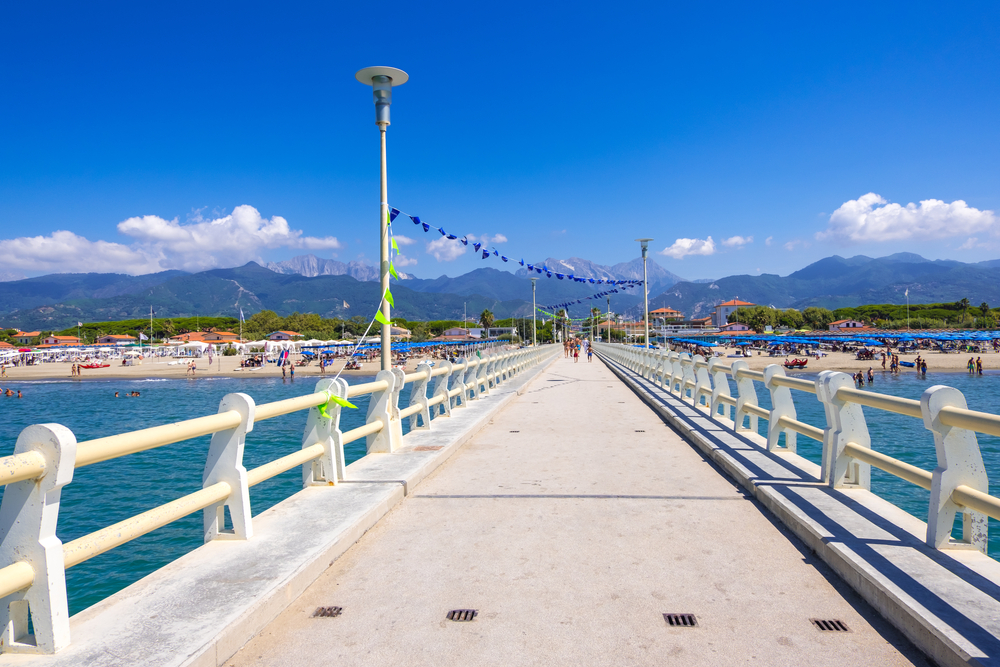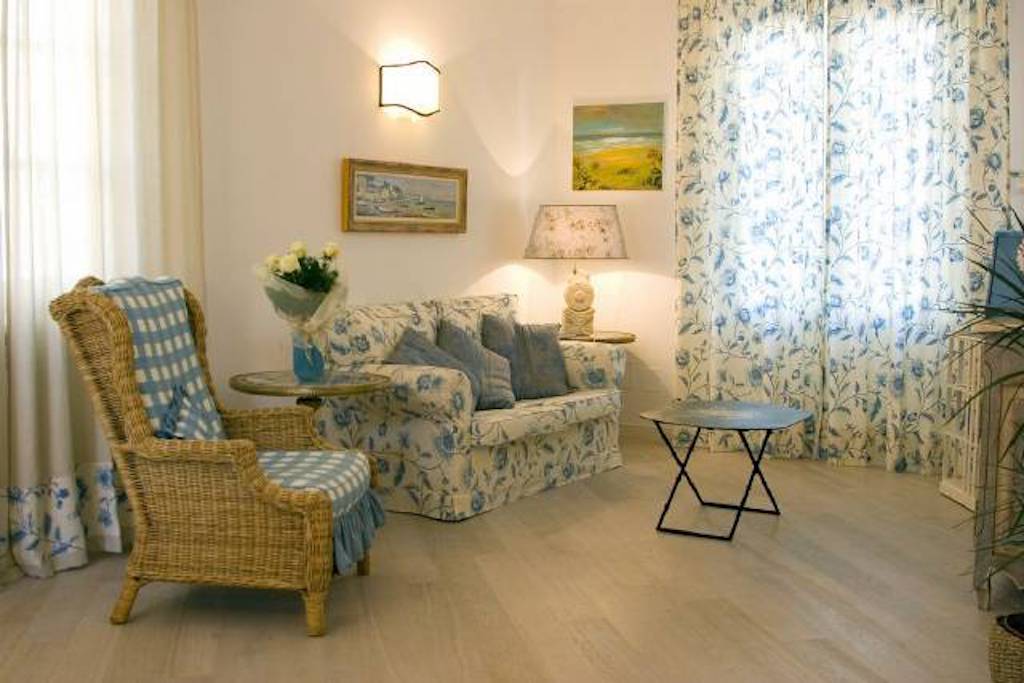Forte dei Marmi is an upmarket seaside town in the province of Lucca in the Tuscany region of Italy. It is extremely popular with rich Italians who flock to the cool of the coast in the Summer months to stay in elegant villas that overlook the sea. It’s perhaps not surprising given its popularity with wealthy Italians, that it’s home to a Polo Club. In October, a polo tournament is held here – Figli del Vento Polo Cup – which can claim to be the only polo event anywhere in Europe that takes place on the beach.
The history of Forte dei Marmi dates back to the 15th century and is connected with the marble trade and a road – the Via di Marina – that linked the mountains inland with the sea. Marble would be transported along this road from the Apuan Alps to the coast. The fort was then built here followed by the first homes in the 1800s. By 1822, Forte dei Marmi had a population of 300, most of whom had roles that were, in some shape or form, connected to the sea. The pier (pontile) was built between 1876 and 1877 with the intention that it would speed up work at the port. It was equipped with a crane (mancina) which helped with the loading and unloading of cargo from ships. Forte dei Marmi continued to grow and the Church of Sant’ Ermete was built to provide the townsfolk with a place to worship.
By the mid 19th century, Forte dei Marmi had started to attract tourists who came to Forte dei Marmi to enjoy the beautiful Tyrrhenian coastline and who opted to stay in Forte dei Marmi for the peace and quiet it offered over its neighbour Viareggio. More homes started to be built for well-to-do families in what is now the Roma Imperiale district of the town. It wasn’t long before the reputation of Forte dei Marmi spread and it was attracting famous artists and intellectuals, politicians and even European nobility.
What to see and do in Forte dei Marmi
The most obvious thing to do in Forte dei Marmi (and the reason most people come) is to relax on its long stretches of sandy beaches. These are very family friendly, particularly as the sea only gets very gradually deeper, making it relatively safe for little ones. The seas are also watched over by lifeguards for added peace of mind. The shore is lined with prettily painted beach huts and is incredibly clean, awarded Blu Flag status for more than 20 years in a row.
You’ll also find a pier along its stretch of coastline where you can soak up the wonderful views out to sea and back again towards the shore. The original pier (pontile) was constructed in 1876 and was historically used to load marble onto the boats, but it was sadly destroyed by the Nazis during WWII. As a result, what you see today is a postwar construction. For those interested in Forte dei Marmi’s past, you can also still see the remains of the crane – La Mancina – that would once have loaded the marble onto the ships. It is situated at the corner of Via Spinetti. It was also destroyed during the Second World War but was rescued from the sea in pieces.

The other main structure of note in the town is the 18th century Lorense Fort (fortino) in the Piazza Garibaldi which is what gave the town its name. It was built on the orders of the Grand Duke of Tuscany, Leopold I, who felt that the stretch of coastline needed greater protection given the growth in the marble industry. Construction was overseen by Barbolani from 1785 to 1788 and the building was topped with a surveillance terrace for the sentry and also consisted of a stable, carriage house and accommodation for the castle keeper, customs officer and gunner. These days, the fort is used as an exhibition space and to host events. On its front wall there is also a statue by Arturo Dazzi.
Also in the Piazza Garibaldi is the Pozzo (well) and a fountain built in 1900 to provide drinking water, as well as a sculpture by Gio Pomodoro entitled La Figlia del Sole. It’s a nice square to relax for a brief time sat on one of the benches that line the square where you can simply watch the people pass by.
It’s worth taking a further stroll from here around the town centre. Here, as well as browsing in its array of upmarket boutiques and shops, it’s worth keeping an eye out for a number of statues and monuments that you will find dotted around the town. These include the war memorial – Monumento ai Caduti – made out of travertine marble which stands in front of the Town Hall. Also of note is the bronze statue by Anna Chromy near the entrance to the pontile. This sculpture entitled Contravento is of a helmsman navigating towards the unknown. And there is also a monument of a pattino (a lifeguard boat typical of this region). On the seafront, look out for the bust of famous local actor Renato Salvatori, who was an acclaimed actor in the postwar period.
Another area of the town that we love to explore is the Roma Imperiale neighbourhood. This is filled with some incredible homes. Some of the most notable are Villa Antonietta, Casa Mann Borgese, Villa Apuana and Villa Costanza (now the Hotel Augustus).
There are also plenty of restaurants serving up superb sea food. Forte dei Marmi can boast four Michelin star restaurants at the time of writing.
Events in Forte dei Marmi
Forte dei Marmi is well known for its festivals and markets. It holds a weekly market every Wednesday in the Piazza Marconi where you will find everything from swimwear to designer fashion (as well as your fair share of fakes!) along with homeware and food. In the Summer months, you will also find a second market held here every Sunday. In the Winter months, this extra Summer market is replaced with antiques markets in both the Piazza Marconi and Vittoria Apuana.
Forte dei Marmi is also famous for the Festival of Sant’ Ermete held between 25 and 28 August each year. Events start with the Amico di Forte dei Marmi Award, include a bonfire which is lit in the Piazza Garibaldi and culminate in an impressive fireworks display on the 28th. In between, on the 27th August, there is a procession that goes from the Piazza Dante to the Church of Sant’ Ermete, carrying the relics of the patron saint. This is followed immediately after by a display of flag wavers in the Piazza Garibaldi, accompanied by plenty of musical performances. On the final day, a market takes over the streets of the town centre and a Mass is conducted in the evening to draw events to a close before the fireworks commence.
Where to stay in Forte dei Marmi
This charming 3 bedroom villa in Forte dei Marmi is located in the heart of the town, within walking distance of shops and restaurants and also within easy reach of the beach. Here, guests enjoy complimentary access to a private beach club.

How to get to Forte dei Marmi
By air: The closest airport to Forte dei Marmi is in Pisa just over 40 km away. The journey to Forte dei Marmi from here by car will take approximately 30 minutes. Alternatively, Florence Peretola airport is approximately 100 km away and has a journey time by car of around one hour.
By train: There is a train station in Forte dei Marmi. This is served by regional trains. Long distance trains stop at nearby Viareggio and from here you will need to change trains to reach Forte dei Marmi. The train from Florence to Forte dei Marmi will take between an hour and 30 minutes and an hour and 40 minutes and involves one change en route.
By sea: The nearest port is in Viareggio.
By car: It is easy to reach Forte dei Marmi by car. Once there, it is important to be aware of the ZTL (Limited Traffic Zone) system which means that those without a permit will incur a hefty fine if they accidentally cross into this zone. This ZTL zone covers a greater area in the Summer than in the off peak months of the year. That said, parking outside this area is pretty straightforward. Head to the seafront to find most spaces around the Viale Italico and Viale della Repubblica. The only exception is at peak times such as during the Wednesday morning market or during the seasonal market held every Sunday.
Tempted to see Forte dei Marmi for yourself? Then check out the Forte dei Marmi villas available from Tuscany villa rental experts, Bookings For You.
